 |
SCHEDULES AND CHARTS:Master Production Scheduling, Program Plan |
| << WORK BREAKDOWN STRUCTURE:Why Do Plans Fail? |
| TOTAL PROJECT PLANNING:Management Control, Project Fast-Tracking >> |

Project
Management MGMT627
VU
LESSON
24
SCHEDULES
AND CHARTS
BROAD
CONTENTS
Detailed
Schedules and Charts
Guidelines
for Preparation of
Schedules
Preparation
Sequence of Schedules
Master
Production Scheduling
Definition
of Master Production Schedule
(MPS)
Objectives
of Master Production Schedule
(MPS)
Program
Plan
24.1
Detailed
Schedules and
Charts:
The
first major requirement of the
program office after the
program goes ahead is
the
scheduling
of activities.
If
the activity is not too
complex, the program office
normally assumes full
responsibility for
activity
scheduling. For large programs,
functional management input is
required before
scheduling
can be completed.
Depending
on program size and contractual
requirements, it is not unusual for the
program
office
to maintain, at all times, a program
staff member whose
responsibility is that of a
scheduler.
This individual continuously develops and
updates activity schedules to
provide a
means
of tracking program work.
The resulting information is
then supplied to the
program
office
personnel, functional management, and
team members, and, last but
not least, is
presented
to the customer.
Note
that the activity scheduling is
probably the single most
important tool for
determining how
company
resources should be integrated so
that synergy is produced. Activity
schedules are
invaluable
for projecting time-phased resource
utilization requirements as well as
providing a
basis
for visually tracking
performance.
In
many cases, most programs
begin with the development of
schedules so that accurate
cost
estimates
can be made. The schedules
serve as master plans from
which both the customer
and
management
have an up-to-date picture of
operations.
24.2
Guidelines
for Preparation of
Schedules:
Regardless
of the projected use or complexity,
certain guidelines should be
followed in the
preparation
of schedules. These are as
follows:
�
Firstly,
all major events and
dates must be clearly
identified. If the customer supplies
a
statement
of work, those dates shown on the
accompanying schedules must be
included. If
for
any reason the customer's
milestone dates cannot be met, the
customer should be
notified
immediately.
�
The
exact sequence of work should be
defined through a network in
which
interrelationships
between events can be
identified.
�
Schedules
should be directly relatable to the
Work Breakdown Structure (WBS). If
the
Work
Breakdown Structure (WBS) is developed
according to a specific sequence of
work,
then
it becomes an easy task to
identify work sequences in
schedules using the
same
163

Project
Management MGMT627
VU
numbering
system as in the Work Breakdown Structure
(WBS). The minimum
requirement
should
be to show where and when all
tasks start and
finish.
�
All
schedules must identify the
time constraints and, if possible, should
identify those
resources
required for each
event.
Here
we see that although these
four guidelines relate to
schedule preparation, they do
not
define
how complex the schedules
should be. Before preparing
schedules, three questions
should
be considered:
�
How
many events or activities
should each network
have?
�
How
much of a detailed technical
breakdown should be
included?
�
Who
is the intended audience for this
schedule?
In
this regard, most organizations
develop multiple schedules:
summary schedules for
management
and
planners and detailed schedules for the
doers and lower-level control.
The detailed
schedules
may
be strictly for interdepartmental
activities. Program management must
approve all schedules
down
through the first three levels of the
work breakdown structure. For
lower-level schedules
(that
is,
detailed interdepartmental), program
management may or may not
request a sign of
approval.
The
need for two schedules is
clear. In larger complicated projects,
planning and status
review
by
different echelons are
facilitated by the use of detailed and
summary networks. Higher
levels
of
management can view the
entire project and the interrelationships
of major tasks
without
looking
into the detail of the individual
subtasks. Lower levels of
management and supervision
can
examine their parts of the
project in fine detail
without being distracted by those
parts of the
project
with which they have no
interface.
One
of the most difficult problems to
identify in schedules is a hedge
position. A
hedge position
is
a situation in which the contractor may
not be able to meet a
customer's milestone
date
without
incurring a risk, or may not
be able to meet activity requirements
following a milestone
date
because of contractual
requirements.
24.3
Preparation
Sequence of Schedules:
For
almost every activity detailed
schedules are prepared. It is the
responsibility of the program
office
to marry all of the detailed
schedules into one master
schedule to verify that all
activities
can
be completed as planned.
According
to the sequence, the program office
submits a request for detailed
schedules to the
functional
managers then prepare summary schedules,
detailed schedules, and, if time
permits,
interdepartmental
schedules. Each functional
manager then reviews his
schedules with the
program
office. The program office,
together with the functional
program team members,
integrates
all of the plans and schedules
and verifies that all
contractual dates can be
met.
Note
that before the schedules
are submitted to publications,
rough drafts of each
schedule and
plan
should be reviewed with the customer.
This procedure accomplishes the
following:
�
Verifies
that nothing has fallen
through the cracks
�
Prevents
immediate revisions to a published
document and can prevent
embarrassing
moments
�
Minimizes
production costs by reducing the number
of early revisions
�
Shows
customers early in the program
that you welcome their
help and input into
the
planning
phase
Once
the document is published, it should be
distributed to all program
office personnel,
functional
team members, functional
management, and the customer.
164

Project
Management MGMT627
VU
The
exact method of preparing the schedules
is usually up to the individual
performing the
activity.
However,
the program office must
approve all schedules. The
schedules are normally
prepared
in
a format that is suitable to
both the customer and contractor and is
easily understood by all.
The
schedules may then be used
in-house as well as for
customer review meetings, in
which
case
the contractor can "kill two
birds with one stone" by
tracking cost and performance on
the
original
schedules.
In
addition to the detailed schedules, the
program office, with input
provided by functional
management,
must develop organization
charts. The organizational
charts tell all
active
participants
in the project who has
responsibility for each
activity. The organizational
charts
display
the formal (and often the
informal) lines of
communication.
Linear
responsibility charts (LRCs) are
also established by the program office.
In spite of the
best
attempts by management, many
functions in an organization may
overlap between
functional
units.
The
management might also wish
to have the responsibility for a certain
activity given to a
functional
unit that normally would
not have that responsibility.
This is a common occurrence
on
short duration programs where management
desires to cut costs and red tape.
Importantly,
care must be taken that
project personnel do not forget the
reason why the
schedule
was
developed.
Summing
this up, the primary
objective of detailed schedules is
usually to coordinate
activities
into
a master plan in order to complete
the project with
the:
�
Best
time
�
Least
cost
�
Least
risk
The
objective can be constrained by the
following obvious
reasons:
�
Calendar
completion dates
�
Cash
or cash flow
restrictions
�
Limited
resources
�
Approvals
In
addition to this, there are
also secondary objectives of
scheduling:
�
Studying
alternatives
�
Developing
an optimal schedule
�
Using
resources effectively
�
Communicating
�
Refining
the estimating criteria
�
Obtaining
good project control
�
Providing
for easy revisions
24.4
Master
Production Scheduling:
We
know that master production
scheduling is not a new concept.
Earliest material
control
systems
used a "quarterly ordering
system" to produce a Master
Production Schedule (MPS) for
plant
production.
165
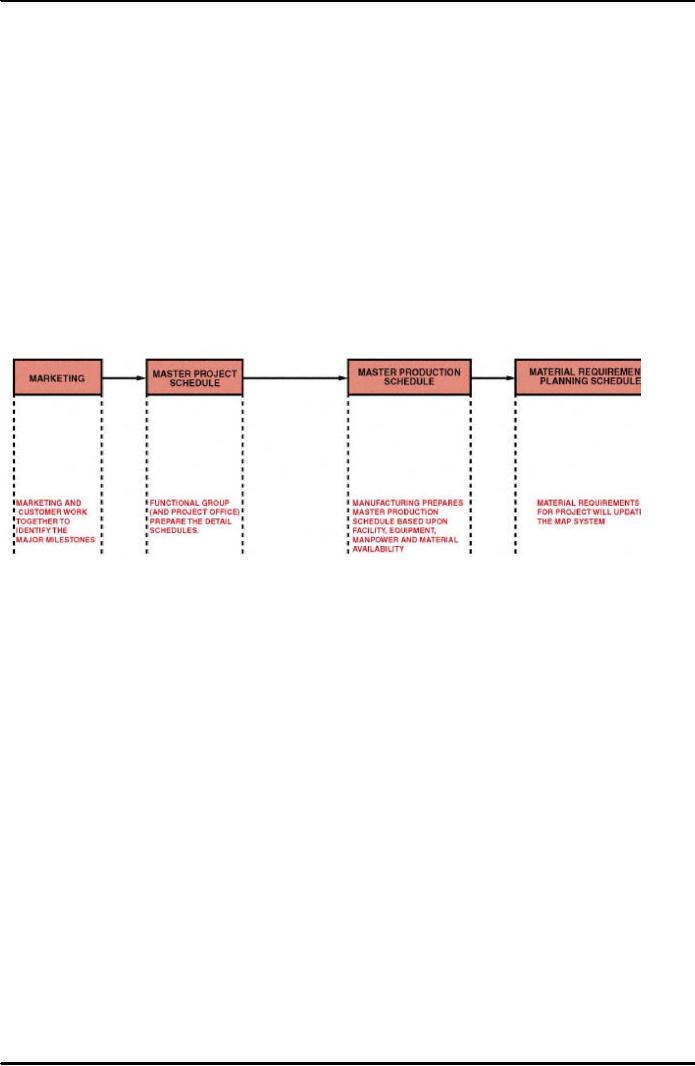
Project
Management MGMT627
VU
This
system uses customer order
backlogs to develop a production plan
over a three-month
period.
The production plan is then
exploded manually to determine
what parts must be
purchased
or manufactured at the proper time.
However, rapidly changing
customer
requirements
and fluctuating lead times, combined
with a slow response to
these changes, can
result
in the disruption of master production
scheduling.
24.5
Master
Production Schedule (MPS)
Definition:
Before
going into the details, it is
important to know what a
Master Production Schedule
(MPS)
is.
A Master
Production Schedule (MPS) is a
statement of what will be
made, how many
units
will
be made, and when they will
be made. It is a production plan,
not a sales plan. The
Master
Production
Schedule (MPS) considers the total
demand on a plant's resources,
including
finished
product sales, spare
(repair) part needs, and
interplant needs. The Master
Production
Schedule
(MPS) must also consider the
capacity of the plant and the requirements imposed
on
vendors.
Provisions are made in the
overall plan for each
manufacturing facility's operation.
All
planning
for materials, manpower, plant,
equipment, and financing for
the facility is driven by
the
master production
schedule.
Figure
24.1: Material
Requirements Pl
166
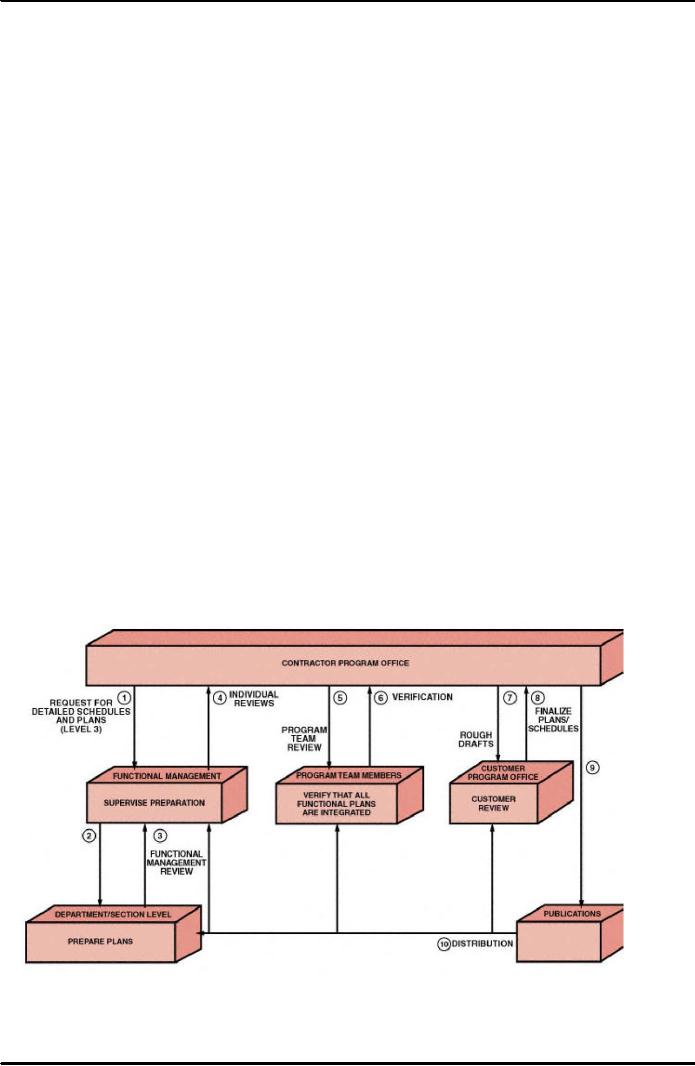
Project
Management MGMT627
VU
under
severe scrutiny during the
1960s when the Department of Defense
required all contractors
to
submit detailed planning to
such extremes that many
organizations were wasting
talented
people
by having them serve as writers instead
of doers. Since then, because of the
complexity
of
large programs, requirements imposed on the program
plan have been eased.
In
case of large and often
complex programs, customers may
require a program plan
that
documents
all activities within the
program. The program plan
then serves as a guideline
for the
lifetime
of the program and may be revised as
often development programs require
more
revisions
to the program plan than
manufacturing or construction programs).
The program plan
provides
the following framework:
�
Eliminates
conflicts between functional
managers
�
Eliminates
conflicts between functional management
and program management
�
Provides
a standard communications tool throughout
the lifetime of the program. (It
should
be
geared to the work breakdown
structure.)
�
Provides
verification that the contractor
understands the customer's objectives
and
requirements
�
Provides
a means for identifying inconsistencies
in the planning phase
�
Provides
a means for early
identification of problem areas
and risks so that no
surprises
occur
downstream
Note
that the development of a program
plan can be time-consuming and
costly. The input
requirements
for the program plan depend on the
size of the project and the integration
of
resources
and activities. All levels of the
organization participate. The
upper levels provide
summary
information, and the lower levels
provide the details. The
program plan, like
activity
schedules,
does not preclude
departments from developing
their own planning.
One
of the key features of the program
plan is that it must
identify how the company
resources
will
be integrated. Finalization of the
program is an iterative process
similar to the sequence of
events
for schedule preparation, shown in the
figure 24.2 below. Since the
program plan must
explain
the events in the figure, additional
iterations are required,
which can cause changes in
a
program.
Figure
24.2:
167
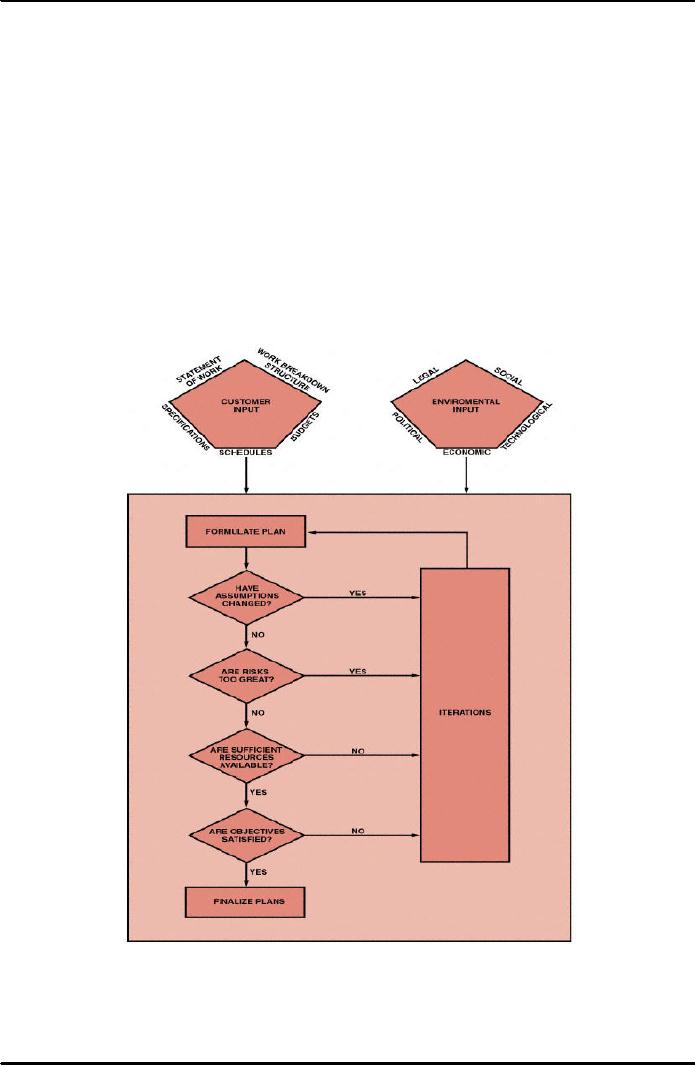
Project
Management MGMT627
VU
as
a cookbook for the duration of the
program by answering the following
questions for all
personnel
identified with the
program:
�
What
will be accomplished?
�
How
will it be accomplished?
�
Where
will it be accomplished?
�
When
will it be accomplished?
�
Why
will it be accomplished?
The
answers to these questions force
both the contractor and the customer to
take a hard look
at:
�
Program
requirements
�
Program
management
�
Program
schedules
�
Facility
requirements
�
Logistic
support
�
Financial
support
�
Manpower
and organization
Figure
24.3: Iterations
for the Planning
Process
In
addition to this, the program
plan is more than just a set
of instructions. It is an attempt to
eliminate
crisis by preventing anything from
''falling through the cracks." The
plan is
documented
and approved by both the customer
and the contractor to determine
what data, if
168

Project
Management MGMT627
VU
any,
are missing and the probable
resulting effect. As the program
matures, the program plan
is
revised
to account for new or missing data.
The most common reasons for
revising a plan are:
�
"Crashing"
activities to meet end
dates
�
Trade-off
decisions involving manpower, scheduling,
and performance
�
Adjusting
and leveling manpower
requests
Usually
the maturity of a program implies
that crisis will decrease.
Unfortunately, this is not
always
the
case.
The
makeup of the program plan may
vary from contractor to
contractor. Most program
plans
can
be subdivided into four main
sections:
i)
Introduction
ii)
Summary
and conclusions
iii)
Management
iv)
Technical
The
complexity of the information is usually
up to the discretion of the contractor,
provided that
customer
requirements, as may be specified in the
statement of work, are
satisfied.
To
begin with, the introductory
section contains
the definition of the program and the
major
parts
involved. If the program follows
another, or is an outgrowth of similar
activities, this is
indicated,
together with a brief summary of the
background and history behind the
project.
The
second section that is the
summary
and conclusion section
identifies the targets
and
objectives
of the program and includes the necessary
"lip service" on how
successful the
program
will be and how all problems
can be overcome. This section must
also include the
program
master schedule showing how
all projects and activities are
related. The total
program
master
schedule should include the
following:
�
An
appropriate scheduling system
(bar charts, milestone
charts, network, etc.)
�
A
listing of activities at the project
level or lower
�
The
possible interrelationships between activities
(can be accomplished by logic
networks,
critical
path networks, or PERT
networks)
�
Activity
time estimates (a natural
result of the item
above)
As
already mentioned, the summary and
conclusion chapter is usually the second
section in the
program
plan so that upper-level
customer management can have a complete
overview of the
program
without having to search
through the technical
information.
The
third section, that is the
management
section of the
program plan contains
procedures,
charts,
and schedules as
follows:
�
The
assignment of key personnel to the
program is indicated. This
usually refers only to the
program
office personnel and team members,
since under normal operations
these will be
the
only individuals interfacing
with customers.
�
Manpower,
planning, and training are
discussed to assure customers
that qualified people
will
be available from the functional
units.
�
A
linear responsibility chart might
also be included to identify to
customers the authority
relationships
that will exist in the
program.
169
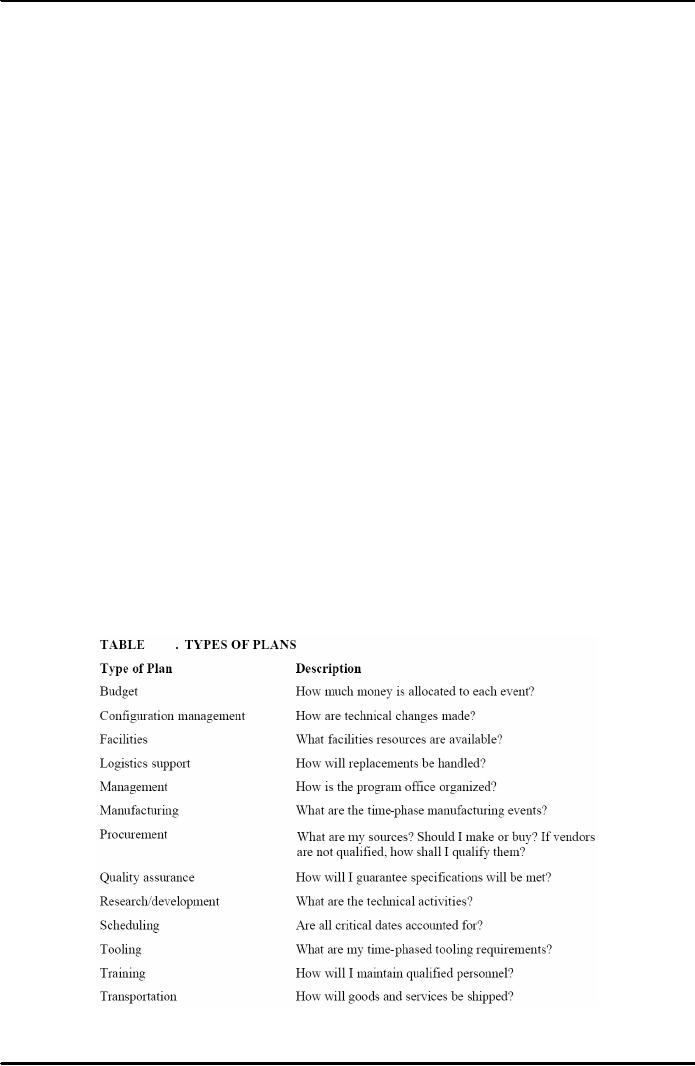
Project
Management MGMT627
VU
There
exist some situations in
which the management section may be
omitted from the
proposal.
For a follow-up program, the
customer may not require
this section if management's
positions
are unchanged.
In
addition to this, the management
sections are also not
required if the management
information
was previously provided in the
proposal or if the customer and contractor
have
continuous
business dealings.
The
fourth section that is the
technical
section
may include as much as 75 to 90 percent
of the
program
plan, especially if the effort
includes research and development.
The technical section
may
require constant updating as the
program matures. The
following items can be included
as
part
of the technical section:
�
Detailed
breakdown of the charts and schedules
used in the program master
schedule,
possibly
including schedule/cost
estimates.
�
Listing
of the testing to be accomplished for
each activity. (It is best
to include the exact
testing
matrices.)
�
Procedures
for accomplishment of testing. This
might also include a
description of the key
elements
in the operations or manufacturing plans as well as a
listing of the facility
and
logistic
requirements.
�
Identification
of materials and material specifications.
(This might also include
system
specifications.)
�
An
attempt to identify the risks associated
with specific technical requirements
(not
commonly
included). This assessment
tends to scare management personnel
who are
unfamiliar
with the technical procedures, so it
should be omitted if at all
possible.
Therefore,
the program plan contains a description
of all phases of the program.
For many
programs,
especially large ones,
detailed planning is required
for all major events and
activities.
The
following Table 24.1
identifies the type of individual plans
that may be required in place
of
a
(total) program plan.
However, the amount of detail must be
controlled, for too
much
paperwork
can easily inhibit
successful management of a
program.
Table
24.1: Types
of Plans
170
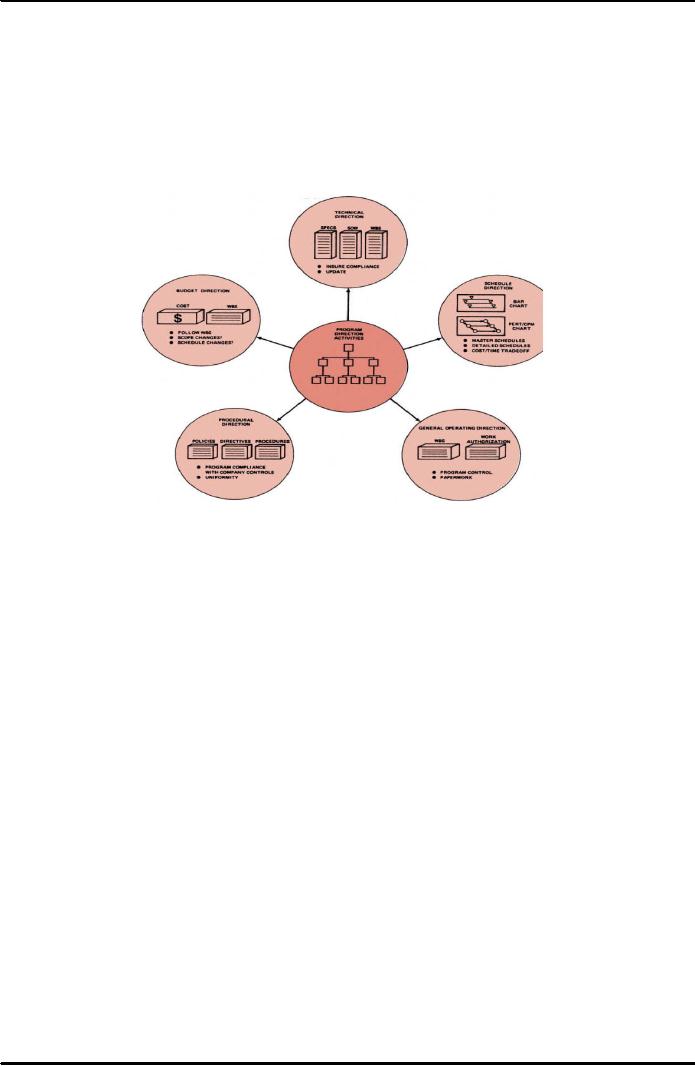
Project
Management MGMT627
VU
Once
agreed on by the contractor and customer, the
program plan is then used to
provide
program
direction. This is shown in the figure
24.4 below. If the program
plan is written
clearly,
then
any functional manager or supervisor
should be able to identify
what is expected of him.
Note
that the program plan should
be distributed to each member of the
program team, all
functional
managers and supervisors interfacing with
the program, and all key
functional
personnel.
The program plan does
not contain all of the
answers, for if it did, there
would be no
need
for a program office. The
plan serves merely as a
guide.
Figure
24.4: Program
Direction Activities
Here
we conclude with a final note
that the program plan may be
specified contractually to
satisfy
certain requirements as identified in the
customer's statement of work.
The contractor
retains
the right to decide how to accomplish
this, unless, of course,
this is also identified in
the
Statement
of Work (SOW). If the Statement of
Work (SOW) specifies that
quality assurance
testing
will be accomplished on fifteen end-items
from the production line,
then fifteen is the
minimum
number that must be tested.
The program plan may show
that twenty-five items are
to
be
tested. If the contractor develops cost
overrun problems, he may wish to
revert to the
Statement
of Work (SOW) and test only
fifteen items. Contractually, he may do
this without
informing
the customer. In most cases, however, the
customer is notified, and the program
is
revised.
171
Table of Contents:
- INTRODUCTION TO PROJECT MANAGEMENT:Broad Contents, Functions of Management
- CONCEPTS, DEFINITIONS AND NATURE OF PROJECTS:Why Projects are initiated?, Project Participants
- CONCEPTS OF PROJECT MANAGEMENT:THE PROJECT MANAGEMENT SYSTEM, Managerial Skills
- PROJECT MANAGEMENT METHODOLOGIES AND ORGANIZATIONAL STRUCTURES:Systems, Programs, and Projects
- PROJECT LIFE CYCLES:Conceptual Phase, Implementation Phase, Engineering Project
- THE PROJECT MANAGER:Team Building Skills, Conflict Resolution Skills, Organizing
- THE PROJECT MANAGER (CONTD.):Project Champions, Project Authority Breakdown
- PROJECT CONCEPTION AND PROJECT FEASIBILITY:Feasibility Analysis
- PROJECT FEASIBILITY (CONTD.):Scope of Feasibility Analysis, Project Impacts
- PROJECT FEASIBILITY (CONTD.):Operations and Production, Sales and Marketing
- PROJECT SELECTION:Modeling, The Operating Necessity, The Competitive Necessity
- PROJECT SELECTION (CONTD.):Payback Period, Internal Rate of Return (IRR)
- PROJECT PROPOSAL:Preparation for Future Proposal, Proposal Effort
- PROJECT PROPOSAL (CONTD.):Background on the Opportunity, Costs, Resources Required
- PROJECT PLANNING:Planning of Execution, Operations, Installation and Use
- PROJECT PLANNING (CONTD.):Outside Clients, Quality Control Planning
- PROJECT PLANNING (CONTD.):Elements of a Project Plan, Potential Problems
- PROJECT PLANNING (CONTD.):Sorting Out Project, Project Mission, Categories of Planning
- PROJECT PLANNING (CONTD.):Identifying Strategic Project Variables, Competitive Resources
- PROJECT PLANNING (CONTD.):Responsibilities of Key Players, Line manager will define
- PROJECT PLANNING (CONTD.):The Statement of Work (Sow)
- WORK BREAKDOWN STRUCTURE:Characteristics of Work Package
- WORK BREAKDOWN STRUCTURE:Why Do Plans Fail?
- SCHEDULES AND CHARTS:Master Production Scheduling, Program Plan
- TOTAL PROJECT PLANNING:Management Control, Project Fast-Tracking
- PROJECT SCOPE MANAGEMENT:Why is Scope Important?, Scope Management Plan
- PROJECT SCOPE MANAGEMENT:Project Scope Definition, Scope Change Control
- NETWORK SCHEDULING TECHNIQUES:Historical Evolution of Networks, Dummy Activities
- NETWORK SCHEDULING TECHNIQUES:Slack Time Calculation, Network Re-planning
- NETWORK SCHEDULING TECHNIQUES:Total PERT/CPM Planning, PERT/CPM Problem Areas
- PRICING AND ESTIMATION:GLOBAL PRICING STRATEGIES, TYPES OF ESTIMATES
- PRICING AND ESTIMATION (CONTD.):LABOR DISTRIBUTIONS, OVERHEAD RATES
- PRICING AND ESTIMATION (CONTD.):MATERIALS/SUPPORT COSTS, PRICING OUT THE WORK
- QUALITY IN PROJECT MANAGEMENT:Value-Based Perspective, Customer-Driven Quality
- QUALITY IN PROJECT MANAGEMENT (CONTD.):Total Quality Management
- PRINCIPLES OF TOTAL QUALITY:EMPOWERMENT, COST OF QUALITY
- CUSTOMER FOCUSED PROJECT MANAGEMENT:Threshold Attributes
- QUALITY IMPROVEMENT TOOLS:Data Tables, Identify the problem, Random method
- PROJECT EFFECTIVENESS THROUGH ENHANCED PRODUCTIVITY:Messages of Productivity, Productivity Improvement
- COST MANAGEMENT AND CONTROL IN PROJECTS:Project benefits, Understanding Control
- COST MANAGEMENT AND CONTROL IN PROJECTS:Variance, Depreciation
- PROJECT MANAGEMENT THROUGH LEADERSHIP:The Tasks of Leadership, The Job of a Leader
- COMMUNICATION IN THE PROJECT MANAGEMENT:Cost of Correspondence, CHANNEL
- PROJECT RISK MANAGEMENT:Components of Risk, Categories of Risk, Risk Planning
- PROJECT PROCUREMENT, CONTRACT MANAGEMENT, AND ETHICS IN PROJECT MANAGEMENT:Procurement Cycles